p.119
p.127
p.135
p.142
p.150
p.159
p.166
p.173
p.180
Effect of Fibre Additives in Concrete on Change of Thermophysical Properties
Abstract:
In recent years, we witnessed a rise in synthetic materials, mainly fibres, used for producing building materials. Fibres are, among other things, used to improve concrete poor energy absorption. Natural fibres reinforcement is found as the solution for low-cost building material mainly in developing countries. As processes in cement-based materials are moisture dependent, in this paper, we compare moisture dependence of thermophysical properties of cement-based materials with synthetic and some natural fibres. Thermal properties for samples with different types and amounts of fibres were measured by temperature response of each test specimen to heat flow impulses. This was done for increasing and decreasing relative humidity reached by artificial wetting in climatic chamber. The best results were achieved for the sample with 10% horse manure. Further on we would like to continue in testing and comparing mechanical properties of the samples as well.
Info:
Periodical:
Pages:
150-156
Citation:
Online since:
October 2020
Authors:
Price:
Сopyright:
© 2020 Trans Tech Publications Ltd. All Rights Reserved
Share:
Citation:


